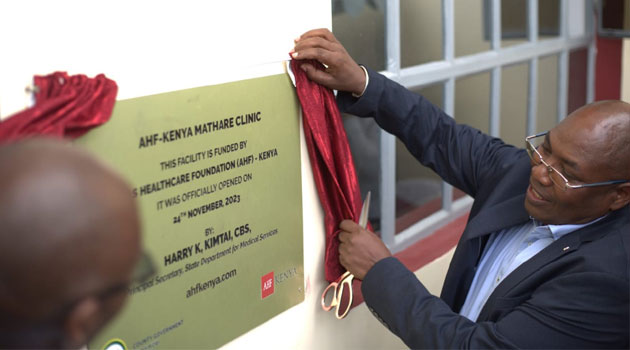Infection
Govt pledges renewed efforts to arrest surge in HIV infections among the youth
NAIROBI, Kenya, Nov 25 — The government has expressed its commitment to combating HIV pandemic amid concerns over a surge in new cases among the youth in some counties.
Health Principal Secretary Harry Kimtai emphasized on Friday that the government is actively collaborating with both state and non-state entities to combat the virus.
Speaking in Nairobi’s Mathare area during the 15th-anniversary celebration of the AIDS Healthcare Foundation (AHF), a global leader in HIV care, Kimtai acknowledged AHF’s pivotal role in providing HIV prevention and care services, including antiretroviral treatment, to over 100,000 Kenyans.
“I express gratitude for the collaborative spirit shown by AHF and other like-minded organizations in addressing challenges posed by the virus. Our commitment to combating HIV remains resolute, and the government has now set up a legal framework to support investment in healthcare from donors and the private sector,” he said during the event which also marked the inauguration of the newly renovated AHF Mathare clinic.
The Mathare clinic is set to serve over 2000 HIV patients, acting as a crucial hub for rapid testing, ensuring prompt knowledge of one’s HIV status, and providing comprehensive treatment and support services to HIV patients.
In support of AHF’s goal to contribute to the elimination of HIV as a public health threat in the country by 2030, PS Kimtai commended the NGO for distributing over 52 million condoms and conducting 3.8 million tests between 2010 and 2023.
Additional testing facilities
The AHF, also largest provider of HIV/AIDS medical care in the world providing treatment and advocacy to about 2 million people in 45 countries, has in the period invested over Sh 7 billion in Kenya through a network of 74 care and treatment facilities and 20 HIV Testing Centres spread across 10 counties.
During the event, Dr. Samuel Kinyanjui, Country Director AHF Kenya, also unveiled the My Care Plan, the AHF promise and commitment to the clients.
The AHF Food for Health Programme, he said, addresses food insecurity among vulnerable communities, which will boost HIV treatment uptake by addressing nutritional needs and ensuring individuals have the strength and resilience to adhere to and benefit from treatment.
Acknowledging the progress, Dr. Kinyanjui noted that in 2022 alone, 1,294,339 individuals received life-saving antiretroviral treatment.
He acknowledged that this marks a significant increase in the number of people living with HIV on treatment.
“The fact that 89 per cent of them achieved viral suppression reflects positive outcomes from collaborative initiatives and we commend all sector players that made this possible,” he said.
On her part, the Chief Executive Officer of the National Syndemic Diseases Control Council (NSDCC), Dr. Ruth Laibon-Masha, emphasized the urgency of addressing rising HIV infections in previously low-burden counties and among the youth.
“This trend (increased new infections), particularly in regions with historically lower burdens, suggests shifts in transmission dynamics. It underscores the need to strengthen community involvement in our ongoing battle against HIV,” she said.
AHF is also currently partnering with Africa’s 100m record holder, athlete Ferdinand Omanyala who also attended the forum and encouraged youth to live a healthy life.
“In the face of two HIV-related deaths every hour in Kenya, let’s champion our health. Use condoms—it’s not just protection; it’s empowerment,” Omanyala who is AHF’s youth ambassador said.
Open conversations
Catherine Mumma, the Nominated Senator for women affairs, advocated for an open conversation on sex and sex education, especially targeting teenagers, as a strategic approach to address the surge in HIV infections among teenagers and adolescents.
Mumma emphasized the importance of engaging in dialogue to effectively reduce the prevalence of HIV among the youth.
The anniversary celebration comes just weeks after the NSDCC revealed that Kenya currently bears the 7th highest HIV burden globally.
New HIV infections among children, adolescents, and young people, in 2022 reached an estimated 62 infections per week among those aged 10-19.
NSDCC also announced that the most affected counties are Kisumu, Nairobi, Homabay, Siaya, Migori, Nakuru, Mombasa, Kakamega, Kiambu, and Kisii.

